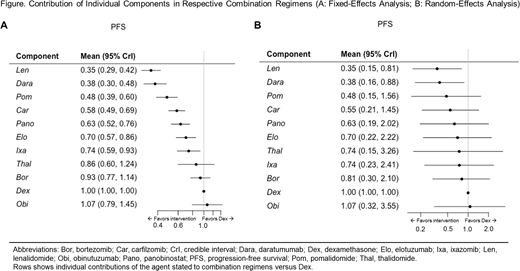Abstract
Background: With the development and approval of new agents, clinicians now have a variety of treatment combinations from which to choose when treating patients (pts) with RRMM. Treatments consist of triplet regimens with agents from the 4 major classes of therapy that have activity in MM. While the activity of the newly approved agents has largely been demonstrated in combination with standard regimens such as Rd (lenalidomide [Len] + dexamethasone [Dex]) or bortezomib (Bor) (with or without Dex), the additional value of each new agent relative to others when included in combination regimens is difficult to determine. As it is only feasible to assess a limited number of possible regimens, it may be informative to explore contributions of individual agents using a Complex Network Meta-Analysis (C-NMA) (Welton et al. Am J Epidemiol. 2009;169:1158-65). This methodology provides an estimate of the contribution of individual agents to the overall regimen efficacy. It can also allow disconnected networks to be analyzed. This study aimed to assess the contribution of individual agents to the efficacy of combination regimens used in RRMM.
Methods: A C-NMA was performed based on a recently published systematic review and meta-analysis that identified 17 randomized controlled trials investigating treatments for RRMM (van Beurden-Tan CHY, et al. J Clin Oncol. 2017;35:1312-19). Where reported, most studies (n=10) involved pts who had received a median of 2 prior regimens. Hazard ratios (HRs) for progression-free survival (PFS) for each regimen compared to the reference treatment (Dex) were taken from the meta-analysis and used to calculate the HR for each individual agent vs Dex. Probability rankings were determined.
Results: Results suggested the most effective individual components of the regimens considered were Len, daratumumab (Dara), and pomalidomide (Pom), all having a PFS HR vs Dex of < 0.50 (fixed-effects model; Figure): Len, HR 0.35 (95% credible interval [CrI] 0.29-0.42); Dara, HR 0.38 (95% CrI 0.30-0.48); Pom, HR 0.48 (95% CrI 0.39-0.60). Bor and thalidomide (Thal) - alternative backbone agents to Rd - appeared to make a relatively minor contribution to combination regimens, having an HR of > 0.85: Thal, HR 0.86 (95% CrI 0.60-1.24); Bor HR 0.93 (95% CrI 0.77-1.14). Thus, addition of Len to Dex reduced the estimated risk of disease progression by 65% vs Dex alone, whereas addition of Bor provided only an estimated 7% reduction in the risk of progression. The newer proteasome inhibitor, ixazomib, and monoclonal antibody, elotuzumab, also appeared to have only a minor contribution to efficacy of combination regimens, having an HR of 0.74 (95% CrI 0.59-0.93) and 0.70 (95% CrI 0.57-0.86), respectively. Effectiveness rankings indicated the 4 Rd-based triplet regimens were the most effective combinations.
Discussion: This analysis represents a potentially useful methodology for assessing relative contributions of different agents to the clinical efficacy of combination regimens available for the management of RRMM, and may suggest combinations likely to deliver greatest clinical benefit. For example, these results suggested adding Dara to an immunomodulatory drug was likely to provide greater clinical benefit than adding Dara to Bor. Where sufficient data are available, effects of synergies between agents in specific regimens could be estimated. For example, immunomodulatory agents have both tumoricidal and immune stimulatory properties, which may potentially promote synergy in combination. This analysis, however, did not take into account differences in median number of prior regimens received between studies. Also, an assumption of C-NMA is that the overall effect of each combination regimen is a product of the treatment effects of the individual agents. Comparison of HRs determined using this methodology with those derived directly from clinical trials would help validate this methodology and enable its wider application. Having an accurate assessment of the benefit of a particular agent in a regimen is important for clinical decision-making and for payers deciding preferred regimens to reimburse to ensure pts have access to the most effective therapies. Dose modifications and discontinuations are frequently employed in combination regimens to maintain tolerability in pts receiving continuous therapy. Relative efficacy data could help guide clinicians to best manage pts on therapy.
Hawkins:Celgene: Consultancy. Ramasamy:Celgene: Honoraria, Membership on an entity's Board of Directors or advisory committees, Research Funding. Dhanasiri:Celgene International: Employment, Equity Ownership.
Author notes
Asterisk with author names denotes non-ASH members.


This feature is available to Subscribers Only
Sign In or Create an Account Close Modal